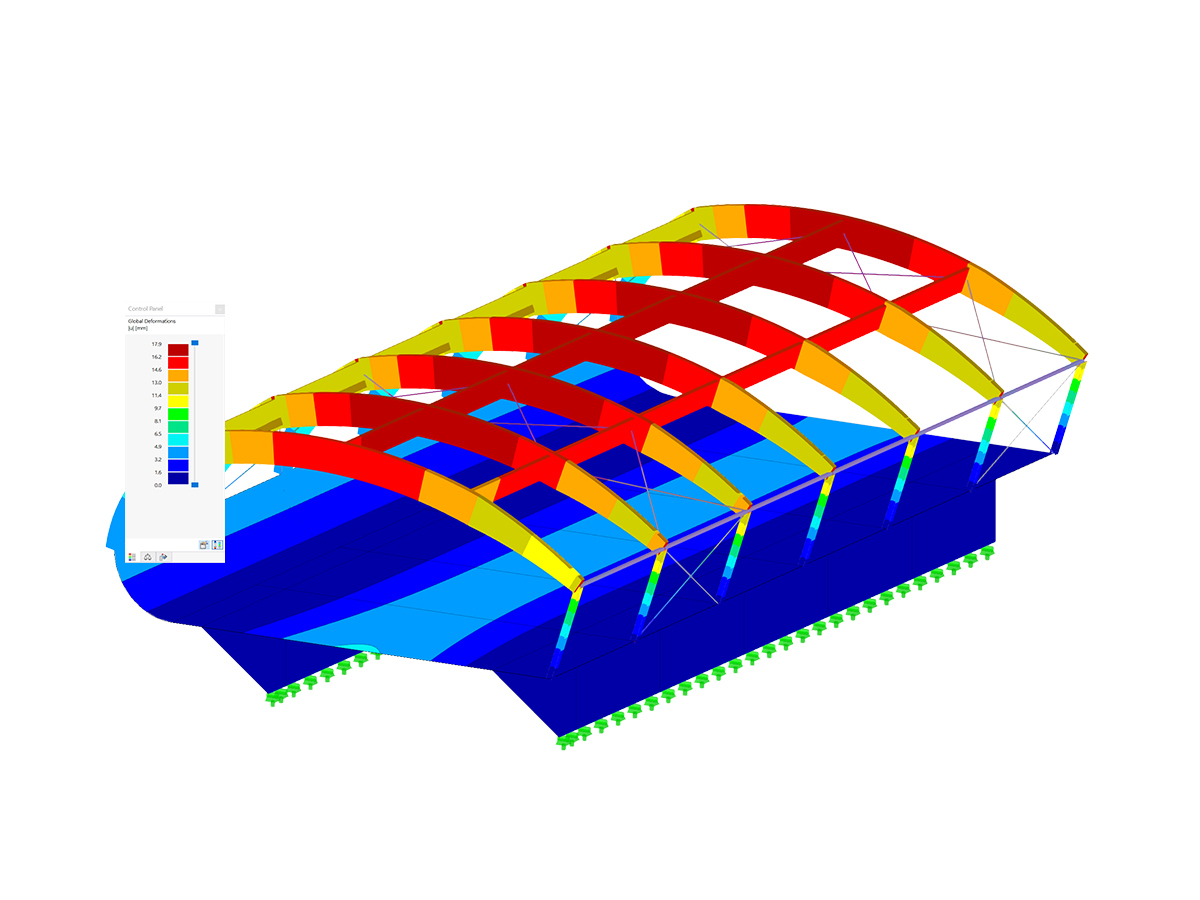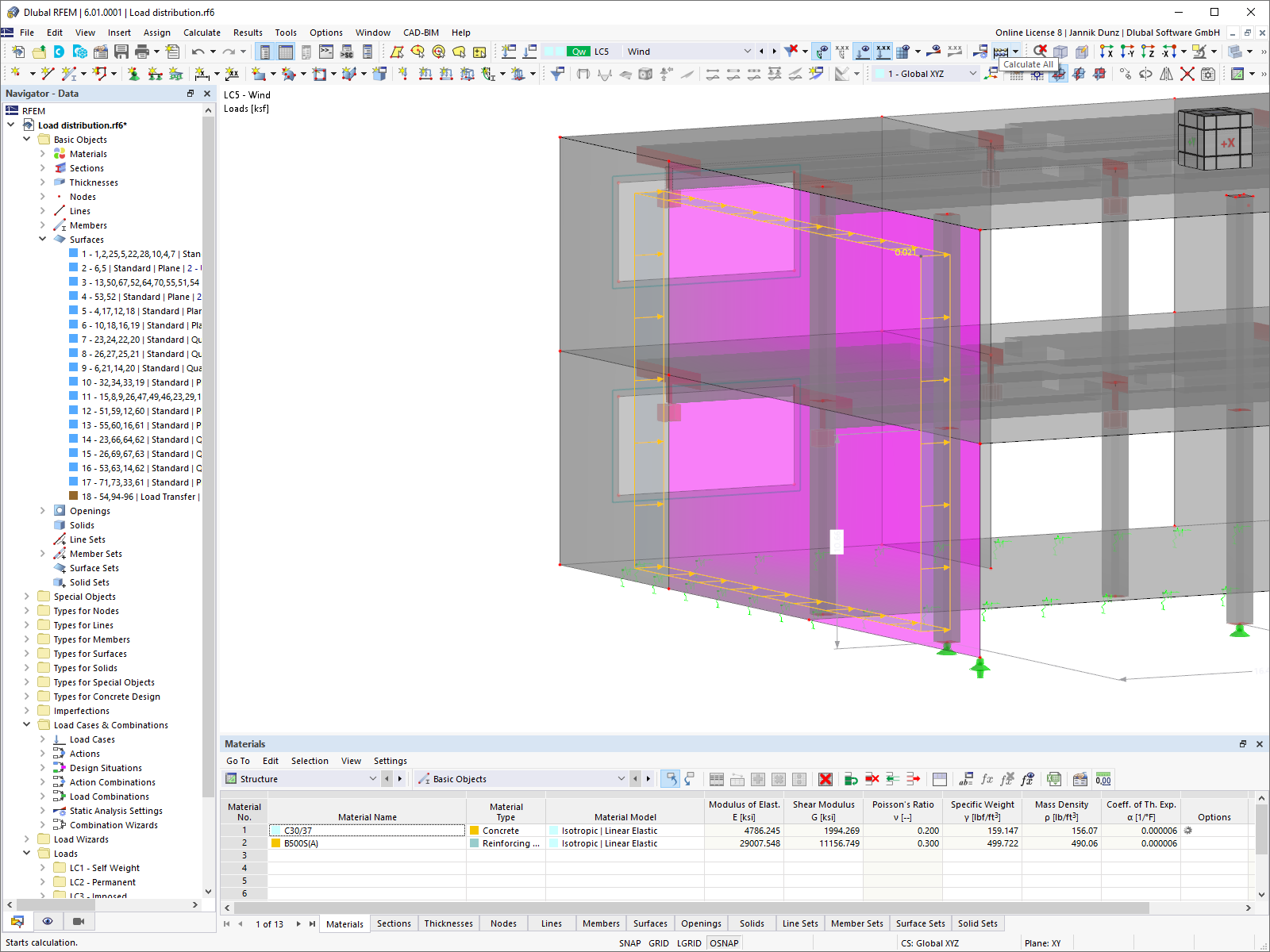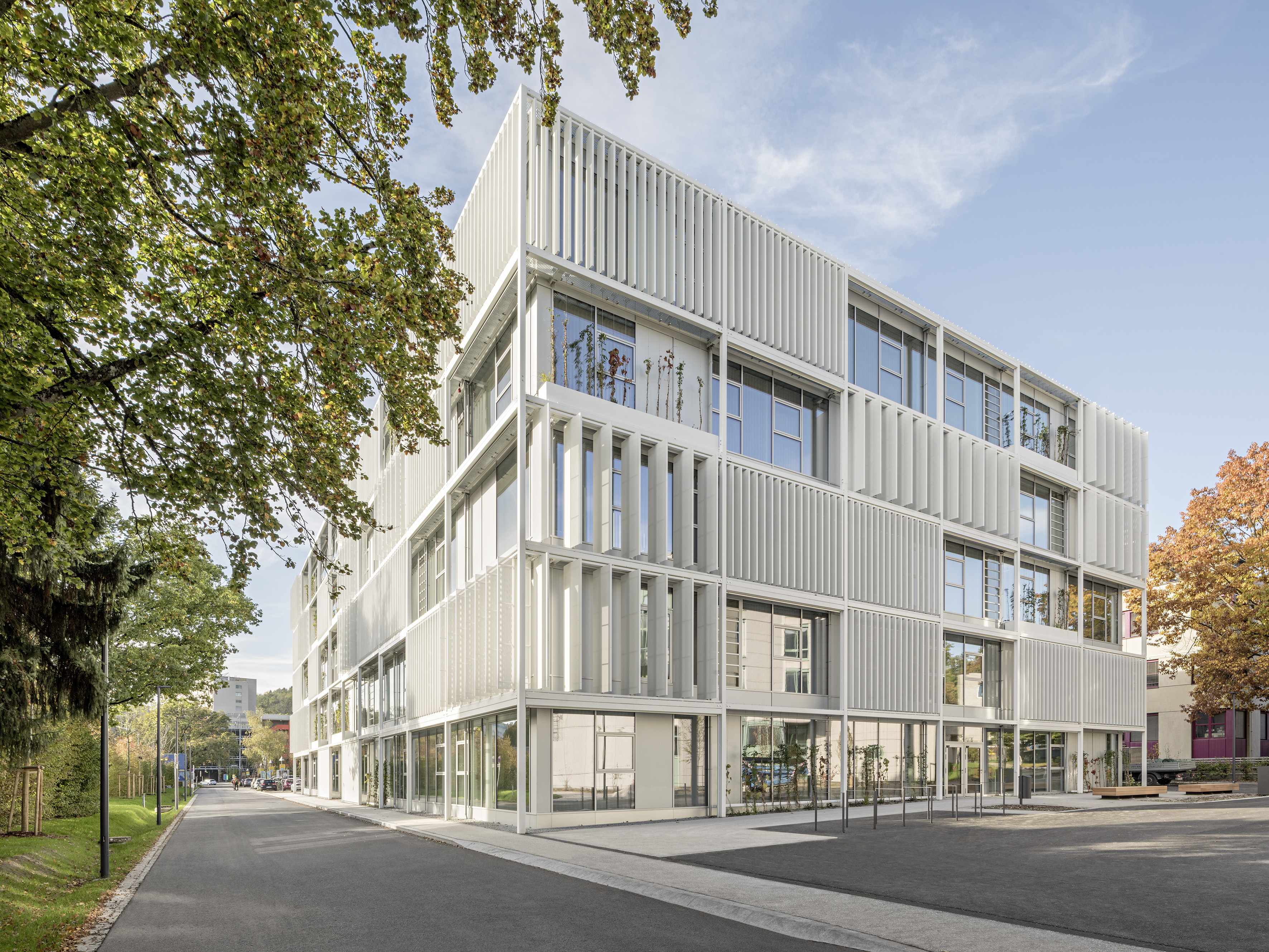New Features and Tools for Efficient Work
Import of Construction Site for Load Determination
Always keep an eye on the natural conditions of your construction site by defining it on a digital map. The address data (including the altitude) as well as the snow load zone, wind zone, and seismic zone are imported automatically. The load wizard also uses this data.
The map is also displayed with the construction site marked in the "Model Parameters" tab.
Go to Explanatory VideoIntegration of All Add-ons
Discover the advantages of working with the various add-ons for RFEM 6 and RSTAB 9. All add-ons are integrated in the programs. This allows seamless interaction between the individual program parts and ensure that your analysis and design runs smoothly. Some examples of this are the determination of the ideal overturning moment of timber beams using the "Torsional Warping (7 DOF)" add-on and the consideration of staggered form-finding processes by means of the "Construction Stages Analysis (CSA)" add-on.
Go to Explanatory VideoOutput of Design Check Formulas
With Dlubal Software, you always have an overview, regardless of whether your projects are from the reinforced concrete, steel, timber, aluminum, or other industry. The program clearly displays the design check formulas used in your design (including a reference to the used equation from the standard). These design check formulas can also be included in the printout report.
Go to Explanatory VideoMember and Member Set Representatives
Make your work with members easier. For members and member sets with the same properties, you can define representatives for model organization, design, and documentation.
The results of these representatives can be easily displayed in the result tables.
Unit Stresses of Sections
Make sure nothing collapses on you: To estimate the resistance of member cross-sections, it is possible to display the unit stresses for the unit loads N = 1 kiP, My = 1 kiP/ft, and so on, when selecting the cross-sections.
Go to Explanatory VideoLoad Transfer Surface
Keep an eye on all surfaces. A surface with the "Load Transfer" stiffness type has no structural effect. You can use it to consider the loads from surfaces that have not been modeled, for example, facade structures, glass surfaces, trapezoidal roof sections, and so on.
Go to Explanatory VideoSurface Contact
Make your work easier. A surface contact serves to describe a contact definition between two or more surfaces that are at a distance from each other It is no longer necessary to create a contact solid between the surfaces.
Go to Explanatory VideoRigid Link
This feature helps you with links. You can easily define rigid links between two lines or surface edges.
Go to Explanatory VideoImperfection Cases
The organization of imperfections is efficiently solved by imperfection cases. The cases allow you to describe an imperfection from local imperfections, equivalent loads, initial sway via table (new), a static deformation, a buckling mode, a dynamic mode shape, or a combination of all these types (new).
Design Situations
Use design situations to support your design checks. They allow you to collect the relevant load situations for design For example, you can define a design situation for the design of different materials.
Go to Explanatory VideoExtension of Snow and Wind Load Wizards
Discover the new functions of the snow and wind load wizards:
- Loading of hybrid models made of members and surfaces (RFEM only)
- Connection to the Geo-Zone Tool (depending on the global construction site definition)
- Switching off surface sides
Modern Online Licensing System
Dlubal Software supports its customers with their construction planning worldwide. The modern online licensing system allows licenses of RFEM, RSTAB, and other programs to be distributed all over the world and assigned to the respective users via the Dlubal Account.
Go to Explanatory VideoScript Manager
Navigate easily and intuitively. Use the script manager to control all input elements using JavaScript via the console or saved scripts.
Improved Printout Report
Discover the fundamentally revised and optimized printout report. It offers you the following innovations, among other things:
- Quick creation due to non-modal printout report environment (parallel work in program and report possible)
- Interactive modification of chapters as well as creation of new user-defined chapters
- Import of PDFs, formulas, 3D graphics, and so on
- Output of the design check formulas used in the design (including a reference to the used equation from the standard)
- Modern printout report design
Faster Calculation
Do you have to calculate multiple load combinations in your models? Then several solvers (one per core) are initiated in parallel, each of which calculates a load combination. This ensures a better utilization of the cores and thus faster calculations.
Go to Explanatory VideoImproved Result Diagram Window
Discover the new features in the result diagram window:
- Parallel work in the result diagram window and in the model
- Optional overlapping display of results (for example, several similar structural components in one image)
Webservice and API
Technology takes you further, also in your daily work with RFEM / RSTAB. The new API technology Webservice allows you to create your own desktop or web-based applications by controlling all objects included in RFEM 6 / RSTAB 9. Entire libraries and numerous functions are available to you. Thus, you can easily perform your own design checks, effective modeling of parametric structures, and optimization and automation processes using the programming languages Python and C#. Dlubal Software makes your work easier and more convenient. Check it out now!
WebService and APIExtension of IFC Interface for Improved Open BIM Process
There are also improvements in the data exchange to make your work process easier. In addition to the import of IFC 2x3 (Coordination View & Structural Analysis View), the import and export of IFC 4 (Reference View & Structural Analysis View) is now supported.
Wind Simulation (RFEM or RSTAB Environment)
Discover the new features in RFEM and RSTAB for the determination of wind loads using RWIND:
- Useful load wizards for generating wind load cases with different flow fields in different wind directions
- Wind load cases with freely assignable analysis settings including a user-defined specification of the wind tunnel size and wind profile
- Comprehensive display of the wind tunnel with input wind profile and turbulence intensity profile
- Visualization and use of the RWIND simulation results
- Global definition of a terrain (horizontal planes, inclined plane, table)
New Model Types
In RFEM, there are new useful result types available for you:
- 2D | XZ | 3D
- 2D | XY | 3D
- 1D | X | 3D
These model types allow you the modeling in a 1D or 2D environment (with optional cross-section rotation in all directions), but also a three-dimensional load application and resulting 3D internal forces.
Go to Explanatory VideoMass Loads
There is also an innovation in the load catalog that will interest you: The Mass Loads type has been added to the catalog!
Opening Loads
This new feature allows you to easily define opening loads (for example, wind loads) for flat loads on openings.
Clipping Box
Keep track of what's really relevant to your project. In addition to the clipping plane, you can now define a clipping box. This allows you to hide the irrelevant objects around a focal point.
Newton-Raphson for Calculations According to Second-Order Analysis
We offer you two additional solution algorithms for the calculations according to the second-order analysis:
- Newton-Raphson
- Newton-Raphson with Postcritical Analysis
Extended Specification of Nodal Mesh Refinements
There's something new for you! To define odal mesh refinements, the options for FE length arrangement have been added:
- Radial
- Gradually
- Combined
Specification of Element Types
Use the specification of the element types for members, surfaces, solids, and so on, to facilitate your input (such as member nonlinearities, member stiffnesses, design supports, and many others).
Dlubal Center
The Dlubal Center ensures that your planning goes quickly and efficiently. Among other things, your projects and model files are managed here in a central location. Detailed information and graphics make it easier for you to assign all models and thus enable uncomplicated, clear processing of the project. Furthermore, your customer data including the licensed programs and add-ons is organized in the Dlubal Center.
Global Management of All Add-ons
Compile the right add-ons for your individual project. All add-ons are directly integrated in the program and, like all required design standards for the respective materials, are managed centrally.
Global Model Parameters
Define as many global model parameters as you want. You can also use them in the documentation.
Structured Data Navigator
You can now work even more efficiently with the Data Navigator. Its clear structure makes it easy to use. The navigator contains assignable types for objects as well as a hyperlink function that allows you to quickly jump to the assigned elements of an object.
New Options for Variable Surface Thicknesses
If you want to define variable surface thicknesses, there are three new options available for you:
- 2 Nodes and Direction
- 4 Surface Corners
- Circle
Statistics for Sections
Keep an eye on your cross-sections. Useful statistical information, such as total length, total volume, total weight, and so on, is displayed for all cross-sections used in your project.
New Section Distribution Types for Members
There are seven new cross-section distribution types available for members (including arrangement function for aligning to a straight edge):
- Tapered at both sides
- Tapered at start of member
- Tapered at end of member
- Duopitch
- Offset at both sides
- Offset at start of member
- Offset at end of member
Cross-Section Library with Short Text Search
Save your time in the cross-section library and use a short text search to quickly find a desired cross-section or cross-section series.
Set of Lines, Surfaces, and Solids
The aim of this feature is to make your design more efficient. In addition to member sets, you can also combine lines, surfaces, and solids into sets. For example, you can consider them as uniform elements in the design.
New Thickness Object
If you want to describe surface thicknesses, you can now use a new thickness object. It can be used for several surfaces. If you modify the thickness of this object, all assigned surface thicknesses are adjusted accordingly in one step.
Member Rotation in Direction of Local Surface Axis
Easily define the rotation of a member in the direction of the local axes of a surface that is, for example, inclined in space.
Structure Modification Object
Use the new useful structure modification object to modify or deactivate stiffnesses, nonlinearities, and objects in a clear and load case-dependent way.
Using and Creating Model Blocks
When working with model blocks, the Dlubal Center helps you. It contains a database of blocks based on the JavaScript code. You can also create and use new blocks, including loading and design.
Surface Eccentricity with Relative Orientation to Another Element
This new feature allows you to define the surface eccentricity depending on the edge of another element (a member or a surface).
Additional Types for Surface Stiffness Modification
Do you want to modify surface stiffnesses? There are now two new types available for you:
- Multiplication factor of total stiffness
- Multiplication factors of partial stiffnesses, weights, and masses
Result Combinations Using Parenthesis Terms
When creating result combinations, you can now also use parenthesized terms.
Individual Global Calculation Parameters for Load Cases and Load Combinations
Use the new structural analysis setting to provide load cases and load combinations with individual global calculation parameters.
New Combination Wizard
Use the new combination wizards to make your work easier. They fill the design situations with load or result combinations on the basis of an automatic or semi-automatic generation conforming to the standards.
Improved Load Wizard
To make your work effiecient and quick, we have added new features to the load wizard. These include locking new members, smoothing occurring concentrated loads, and considering eccentricities as well as cross-section distribution.
Determination of Member Loads from Surface Loads by Specifying Cells and Surfaces
Another useful features in the Load Wiyard is the determination of member loads from area loads by defining surfaces (using corner nodes) and cells in a definition.
Eccentricity of Nodal and Member Loads
Always keep an eye on the stability of your structures: You can now consider eccentricities for nodal and member loads.
Load Options for Member Sets, Line Sets, Surface Sets, and Solid Sets
Now, you have new options for your design: With the introduction of line sets, surface sets, and solid sets, new load options have also been added for loading these sets. Try them yourself!
Global Organization of User-Defined Coordinate Systems
A change in favor of more efficient work withh the program: Your user-defined coordinate systems for input and analysis purposes are now organized globally under the guide objects.
Organization of Different Object Snaps
To facilitate your work, you can now define several object snaps for different operating tasks.
Object Selection as New Guide Object
This feature creates more order. The new guide object "Object Selection" allows for generic filtering of various objects:
- Basic Objects
- Types for Nodes
- Types for Lines
- Types for Surfaces
- Load Wizards
- Loads
- Guide Objects
The object selection provides you with many interactive application possibilities at various program locations.
Tabular Reference Description for Dimension Lines
A clear arrangement of the Dlubal programs has a high priority. Therefore, the reference descriptions of incremental dimension lines are now given in tabular form for a better overview.
Implementation of SAF Format
Take your structural design one step further. RFEM 6 and RSTAB 9 support now a new file format for structural design, Structural Analysis Format (SAF). For this, both programs allow for the import as well as the export. SAF is a file format based on MS Excel, intended to facilitate the exchange of structural analysis models between different software applications.
Tabular Unit Settings
You can now change certain units in the form of a tabular user interface. You can now change certain units in the form of a tabular user interface.
New File Formats for Export
An improvement that will benefit your smooth workflow: You can now export your RFEM and RSTAB models in XML, SAF, and VTK (results from RWIND).
New Local Axis Definition for Members
The improvements in the international context are not neglected either. A new local axis specification (y upwards) has been added for the Anglo-American region.
New Graphic Printout Option with Preview Image
Various new options make it easier for you to print graphics in the future. Your new graphic printout dialog now includes:
- Library-controlled mass print function for all program graphics
- User-defined print area selection
- 3D function for later 3D functionalities in the final PDF
- Automatic separation of images for scale prints and the function for displaying an overview image
Creation of Parts Lists
Benefit from better organization. It is now possible for you to create cross-section and material-based parts lists.
Using Log Files
Your satisfaction with the Dlubal programs is our top priority. The new program generation RFEM 6 and RSTAB 9 allows you to send log files to our company via online registration. We use this to better analyze and improve our programs for your applications. By default, this setting is activated under the program options. However, you can rescind your consent in the programs at any time.
List Box for Organized Interactive Table Structure
An innovation for more efficiency when using tables: The tables are now sorted in two list boxes, which allows you to easily navigate the various input and result tables.
Result Table Manager
There are also optimizations for the clear arrangement of your results. To better display the results, you can reduce the displayed columns and rows with the new Result Table Manager.
Material Type Control
Keep track of your design checks. The material type of a material is used to clearly define the design-relevant properties.
Determination of Independent Surface Parts for Intersections
The following new features are available for your work with surfaces: When creating surface intersections, independent surface components are now created for you instead of surface components.
Improved Overview in Material Library
Discover what's new in your material library. The material series are now listed here. It is also possible to directly find your desired material in the library by using the free text search function.
Calculate Your Price

The price is valid for United States.





In the Snow Load Wizard, you can optionally consider snow overhang and snow guard when generating snow loads according to Eurocode.

The Construction Stages Analysis (CSA) add-on allows you to modify the object and design properties of members, surfaces, and so on, in the individual construction stages.

During the calculation, you can display the model deformation for the calculation steps graphically in the calculation progress window.

In the wind simulation, it is possible to consider member coatings (for example, from ice loads).
How can I calculate and read effective lengths of a member properly?
How can I find out which graphics card is actually used by RFEM 6?
I'm experiencing problems with the graphics card. What can I do?
Can I use the Dlubal API in Rhino and Grasshopper?
In the Steel Joints add-on, I get high utilization ratios for preloaded bolts in the tension design. Where do these high utilization ratios come from and how can I evaluate the load-bearing reserves of the bolt?
How can I transfer my model from ETABS to RFEM 6?























.jpg?mw=1024&hash=796b34c5c287d4c0a3bd398e348931e06cb6f836)




































.jpg?mw=1024&hash=2ba382584f125c2998ae1d7a9fa8918ee99e41e0)






















































-querkraft-hertha-hurnaus.jpg?mw=350&hash=3306957537863c7a7dc17160e2ced5806b35a7fb)




